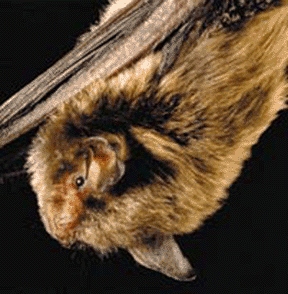
Tsetse are large, biting flies that inhabit much of tropical Africa. Tsetse flies include all the species in the genus Glossina, which are placed in their own family, Glossinidae. The tsetse is an obligate parasite, which lives by feeding on the blood of vertebrate animals. Tsetse has been extensively studied because of their role in transmitting disease. They have a pronounced economic impact in sub-Saharan Africa as the biological vectors of trypanosomes, causing human and animal trypanosomiasis.

The Indiana bat is a medium-sized mouse-eared bat native to North America. It lives primarily in Southern and Midwestern U.S. states and is listed as an endangered species. The Indiana bat is grey, black, or chestnut in color and is 1.2–2.0 in long and weighs 4.5–9.5 g (0.16–0.34 oz). It is similar in appearance to the more common little brown bat, but is distinguished by its feet size, toe hair length, pink lips, and a keel on the calcar.
The false network catfish is a tropical freshwater fish belonging to the subfamily Corydoradinae of the family Callichthyidae. It originates in inland waters in South America, and is found in the Amazon River in Loreto, Peru, and Amazonas, Brazil.

Pseudosphex is a genus of tiger moths in the family Erebidae. The genus was erected by Jacob Hübner in 1818. These moths are mimics of a variety of Hymenoptera. The prefix pseudo means "false", and Sphex is a genus of wasps.

Melophagus ovinus, or the sheep ked, is a brown, hairy fly that resembles a tick. This wingless fly is about 4 to 6 mm long and has a small head; it is a fly from the family Hippoboscidae. They are blood-feeding parasites of sheep. The sheep ked feeds on the blood of its host by inserting its sharp mouthparts into capillaries beneath the skin. The legs of the sheep ked are very strong and tipped with claws. Sheep keds live their whole lives in the wool of sheep. They are most commonly found on the neck, shoulders, and underbelly of the host animal. Although they are often referred to as the “sheep tick”, sheep keds spend their entire lifecycle on their hosts, which is distinguishable from the characteristics of a true tick. Additionally, sheep keds have six legs, whereas true ticks have eight legs.

Originally known as the Oklahoma Bat Caves National Wildlife Refuge, Ozark Plateau National Wildlife Refuge was established for the protection of endangered bats and their habitat. The refuge is made up of several parcels of land located in northeastern Oklahoma. These parcels contain numerous caves considered crucial for the bats' survival.
Chodsigoa is a genus of shrews in the tribe Nectogalini.

The lesser Taiwanese shrew is a rare species of shrew in the Soricomorpha order.
Maoricrypta sodalis is a species of sea snail, a marine gastropod mollusk in the family Calyptraeidae, the slipper snails or slipper limpets, cup-and-saucer snails, and Chinese hat snails.

Klossiella is a genus of parasitic alveolates of the phylum Apicomplexa. Species in this genus infect the renal tract of mammals and intestinal tract of snakes.
Eupithecia sodalis is a moth in the family Geometridae. It is found in Equatorial Guinea (Bioko).
Sodalis glossinidius is a species of bacteria, the type and only species of its genus. It is a microaerophilic secondary endosymbiont of the tsetse fly. Strain M1T is the type strain. Sodalis glossinidius is the only gammaproteobacterial insect symbiont to be cultured and thus amenable to genetic modification, suggesting that it could be used as part of a control strategy by vectoring antitrypanosome genes. The organism may increase the susceptibility of tsetse flies to trypanosomes.
Crataerina melbae is a species of biting fly in the family of louse flies Hippoboscidae. Its hosts are swift species including the Alpine, Pacific, Common and mottled swifts.
Sodalis is a genus of bacteria within the family Pectobacteriaceae. This genus contains several insect endosymbionts and also a free-living group. It is studied due to its potential use in the biological control of the tsetse fly. Sodalis is an important model for evolutionary biologists because of its nascent endosymbiosis with insects.

Coelioxys sodalis is a bee from the family Megachilidae, one of numerous kleptoparasitic bees in the tribe Megachilini. Members of the genus Coelioxys exhibit kleptoparasitic behavior in that they lay their eggs in the nests of other bees, typically those of the related genus Megachile. As this behavior is similar to that of cuckoos, such bees are referred to as cuckoo bees. These host-parasite relationships are complex. Host insects of the brood parasite C. sodalis include Megachile melanophaea, M. texana, and M. rotundata.

Coelioxys, common name leaf-cutting cuckoo bees or sharp-tailed bees, is a genus of solitary kleptoparasitic cuckoo bees belonging to the family Megachilidae.

Lake Arin is a soda lake in Adilcevaz district of Bitlis, Turkey. The lake is to the east of Adilcevaz and separated from Lake Van, the biggest lake of Turkey by alluvial deposits of only 1 kilometre (0.62 mi) width.
Cyclotrachelus sodalis is a species of woodland ground beetle in the family Carabidae. It is found in North America.
Teuchothrips is a genus of thrips in the family Phlaeothripidae.
Fatma Serap Aksoy is a Turkish–American medical entomologist.









